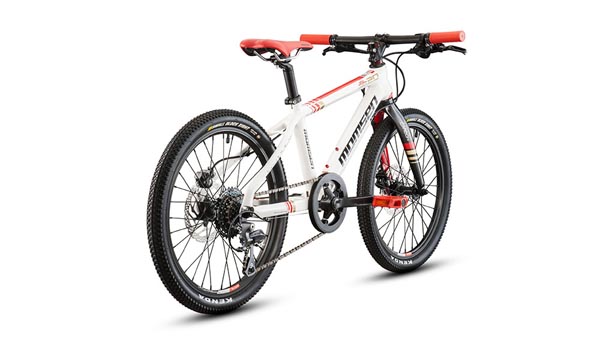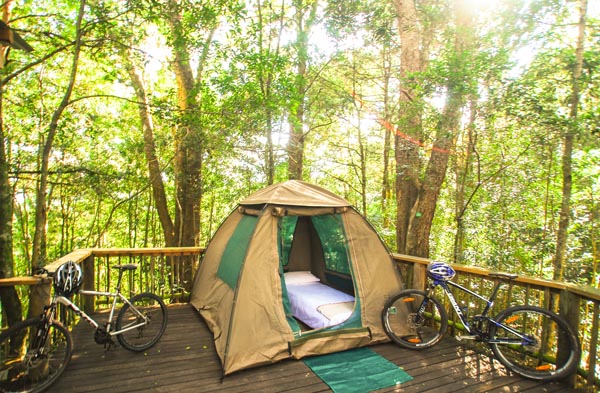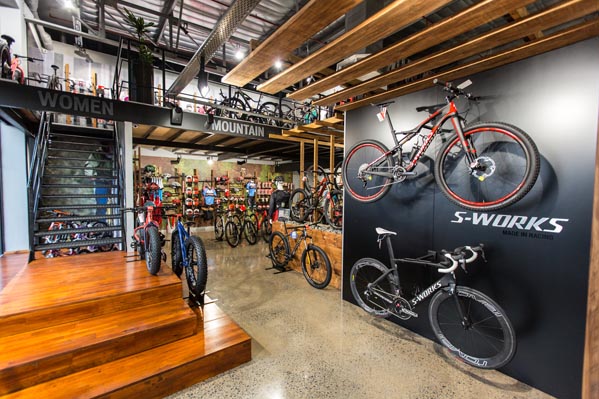Money markets, weather, fashion – all roll along in their own dynamic way from day to day. Predictions and forecasts from experts try make sense of where they MIGHT head. Sometimes they’re right. We have no expert knowledge in any of those fields. But we do know mountain biking. Here’s what we predict will be significant in the South African market in the year ahead. – By the TREAD Editors
1. PLUS BIKES
We gushed on about the benefits of Plus in Issue 36 and then got frustrated because there was a long wait before Plus bikes started arriving in South African stores. SCOTT, with eight models and Specialized, with four models seem to be leading the pack into this platform, which essentially offers increased traction and stability and will be best suited to those who lack confidence and those who want to go faster on descending trails and/or around corners.
Fad or forever? Forever – Plus offers more control and speed and that’s going to be eagerly embraced.

2. 11-SPEED TRICKLEDOWN
We’ve seen it happening already, but expect even more 11-speed trickledown happening this summer and into next year. With Shimano’s Deore XT 1×11 group and SRAM now offering GX on 1x and 2x  drivetrains, 11-sprocket clusters are no longer the preserve of the privileged few. Think back a few years to when hydraulic disc brakes were only found on the most expensive bikes. That’s a trickle-down success story if ever there was one. We reckon 11-speed will go the same way.
drivetrains, 11-sprocket clusters are no longer the preserve of the privileged few. Think back a few years to when hydraulic disc brakes were only found on the most expensive bikes. That’s a trickle-down success story if ever there was one. We reckon 11-speed will go the same way.
3. FEMALE FOCUS
Finally the mountain bike industry is embracing women – properly. There are fewer shrink-it-and-pink-it bikes being offered and more women-specific designs – shorter top-tubes, women-tuned suspension, more appropriate gearing, adjustable reach brake levers, narrower handlebars, women-specific saddles and smaller frame/wheel sizes. Then there’s all the cool women’s mountain biking clothing that’s designed for women to look and feel good in. Equal prize money at more and more races, women-only trail days/events/skills clinics… It’s the best time to be a women mountain biker in South Africa and it’s likely going to get even better in 2016.

4. ELECTRONIC GEARS
Last year Shimano launched Di2, electronic gear shifting for mountain biking. This year they sold it to those that can afford it (around R17000 for a full set-up). Next year, they’ll sell more because it actually works. Really well. There’s limited opportunity to actually test-ride it in South Africa, but once you’ve ridden with someone that has it on his/her bike and he/she gives you a try, you realise that it’s not only exceptionally efficient, it’s also reliable and intuitive. It does remain costly though with trickle-down likely to move a lot slower than say hydraulic disc brakes. There’s a poorly kept secret that SRAM is in the final stages of developing its own electronic shifting system – and, in typical one-upmanship style – going wireless…

All electronic shifting, wired or wireless is expected to remain costly, but we believe it’s going to be something more and more serious mountain bikers will start investing in over the next year.
5. PROPORTIONATE SIZING
We first saw it with South African brand, Momsen. It’s Small-sized VIPA model in 2014 has built around 27.5-inc wheels with the Medium, Large and Extra Large sizes using 29-inch wheels. Momsen scrapped this for 2015 and 2016, but we’ve noticed a number of other brands offering XS and S sized bikes with 27.5-inch wheels. It does make sense when you consider that people (mostly women) that require XS or S frame sizes, struggle to roll the 29er wheels and additional bike weight up steep ascents. In South Africa, the epicenter of 29ers, it’s not likely to become a significant thing, but globally we reckon it’s going to become quite common.
6. 1x CONVERSION
Should I, shouldn’t I? That’s been a question we’ve been asked more than any other in the past year or so. Stick with two chainrings (2x) or switch to a single chainring? The latter is simpler, takes a bit of weight from the bike and cleans up the handlebar area. But it requires you to adapt to bigger gear-ratio changes between shifts than you’ve become accustomed to. So you find yourself pushing harder on the pedals to climb – not a bad thing really, just a comfort-zone crusher. And you also find yourself becoming quite well educated on the various gear ratios and how they feel when you’re riding. For those that live in relatively flat areas, 1x is a no-brainer really. For the rest, well, your dilemma is greater but so is your choice of 1x conversion parts, from chainrings to clusters to individual cluster sprockets…
7. DROPPER POSTS
They’re not new, but dropper seatposts are the bee’s knees man. You only have to ride with one on a couple of trail outings to realise just what a difference it makes to your riding. With a traditional, static seatpost, we spend a lot of energy moving our bodies into unnatural  positions to accommodates our saddle. When you move it out of the way though, you can tackle technical trails and steep descent with greater control, confidence and speed. And that folks is really all that matters. Dropper posts are pretty common on All-mountain and Trail bikes, but are pretty costly still, especially the remote hydraulic ones. We spotted Olympic XCO champion Jaroslav Kulhavy riding a dropper post during a race this year. The additional weight is the limiting factor for most XCO racers, but as courses become steeper and gnarlier and the weight penalty becomes less of an issue, expect a dropper post revolution to begin. And we reckon that may begin in 2016…
positions to accommodates our saddle. When you move it out of the way though, you can tackle technical trails and steep descent with greater control, confidence and speed. And that folks is really all that matters. Dropper posts are pretty common on All-mountain and Trail bikes, but are pretty costly still, especially the remote hydraulic ones. We spotted Olympic XCO champion Jaroslav Kulhavy riding a dropper post during a race this year. The additional weight is the limiting factor for most XCO racers, but as courses become steeper and gnarlier and the weight penalty becomes less of an issue, expect a dropper post revolution to begin. And we reckon that may begin in 2016…
8. KIDS BIKES THAT AREN’T
We’ve always puzzled at how proportionately heavy and inefficiency kids mountain bikes are. And how hard it is for them to reach the brake levers, never mind pull them… Imagine riding a bike that weighs half your bodyweight and is exceptionally difficult to stop/control! Not exactly an exciting prospect is it? Well that’s been the burden of kids for ages. But that’s changing. We saw it with Momsen two years ago and are seeing with other brands now too.

Momsen now offers an 8.58kg 20-inch mountain bike. It has a carbon frame and fork and hydraulic disc brakes and that makes is a dream bike for any kid. Yes it’s more expensive. But you want the best for your kids right? We don’t see many other brands offering a carbon 20-inch frame, but we do see them making their kids bike lighter and more practical to be able to cope with the enthusiasm of the little ones.
9. TRAIL RIDING
We predict more trail riding happening in 2016. A lot more. While we have a thriving racing calendar and world-class events, a tough economy, events using the same routes year after year (repetition fatigue) and the increase in mountain bike-specific trails and trail parks, will all combine to increase the popularity of trail riding. More people riding bikes more often, because they want to. That’s what mountain biking’s culture was built on.
10. CYCLO-TOURISM
We have great weather (yes we damn well do), incredibly diverse landscape and a ridiculous amount of gravel roads. We don’t have to do all of our mountain bike riding on singletrack or in races. We’re seeing the growth of tour companies offering mountain biking. On a bicycle all your senses are stimulated – constantly – and that makes it the best way to experience this beautiful land. There’s no race pressure; you can ride with family and friends; and you can drink beer/wine every night. What’s not to love about that?

11. BOOST
Wider is the essentially what boost offers – wider rear hub (by 6mm),  wider front hub (by 10mm) and, as a result, the ability for brands to design wider rear triangles and forks, which allow for wider rims and tyres. What for? Well, wider means greater stability which leads to greater control and more responsive riding, that’s what for. Boost is currently found on the new Plus model bikes, but we anticipate it will become widespread on the other ‘regular’ platforms soon and probably the dominant dimension from 2017 and beyond.
wider front hub (by 10mm) and, as a result, the ability for brands to design wider rear triangles and forks, which allow for wider rims and tyres. What for? Well, wider means greater stability which leads to greater control and more responsive riding, that’s what for. Boost is currently found on the new Plus model bikes, but we anticipate it will become widespread on the other ‘regular’ platforms soon and probably the dominant dimension from 2017 and beyond.
12. ELECTRIC-ASSIST BIKES
They’re big in Europe, but will they get big in South Africa? Electric-assist mountain bikes allow relatively unfit people to still enjoy mountain biking without a glucose drip. They aren’t like a motorcycle because you still have to pedal, but when sensors detect you’re beginning to struggle the motor kicks in to help you maintain a reasonable pace. They’re actually banned on the trails by IMBA in the USA because they’re not considered human-powered. We can’t see them getting big in South Africa, not in the near future anyway. Why? Well South Africans tend to like getting fit and conditioned for their chosen form of exercise/activity. We like to hurt and suffer physically. No pain, no gain, right? Also, to really make the most of an electric-assist mountain bike, you need some level of trail-taming skill. They’re cool to ride, but maybe not cool to fork out the cash for. We reckon they’ll be a very niche category in this country, if they even achieve ‘category’ status. But expect to see substantial growth in Europe.
13. DIRECT SALES
We’re predicting more and more smaller bike brands will start to sell directly to the public. With the Rand both weak and vulnerable, big brands like Specialized launching virtually a new retail store every month and the establishment of bicycle service/maintenance centres, it just makes sense. It will be gradual and organic, but we expect it’s going to begin in 2016. Canyon, one of the world’s leading bike brands, has been selling direct since it was established; Trek announced recently it is changing to a more direct retail model. There will still be bike shops though, but they’ll need to offer more than just product and servicing to create their own loyal community.
14. TRAIL BIKE SALES TO INCREASE
We’ve been banging on about it for a couple of years and it finally seems to be hitting home. XC race bikes are fast, sleek, light and win races; but they’re not exactly the right bike for most of us. By buying an aggressively angled, short-travel race bike, we’re basically putting ourselves in the same category as Christoph Sauser, Phil Buys and Ariane Kleinhans. Are we? No. So why ride bikes exactly like theirs? We need to ride bikes that are designed for greater comfort and increased control. In other words, bikes that help generate smiles, not grimaces. For the majority of the trails and races in this country, that would be a Trail bike – 66-69-degree headtube angle, longer toptube, shorter stem (40-80mm), wider handlebars, longer wheelbase, dropper seatpost, bigger brake rotors (mainly upfront), more robust tyres and more suspension travel (110-150mm). That folks, is the South African mountain bike sweet spot. Start there when buying your next/first bike. You’ll thanks us.
15. MAINTENANCE CENTRES
Much like the motor industry, we expect specialist workshops/maintenance centres to become more popular. There are already some, such as Torq Zone and Sprocket and Jack in Gauteng, with more expected as mountain bikers become more demanding with the quality of work done on their bikes, which are, let’s face it, very high value luxury items.
16. RETAIL MEGASTORES
Megastores is probably too strong a word, but we couldn’t think of anything else that really describes the trend of many bike shops either collaborating to create a more powerful chain with different branches, or simply following the Cycle Lab model and creating a massive bike shop that sells pretty much everything from (almost) every brand. It’s a profit margin war out there and scale matters…

TREAD Magazine is sold throughout South Africa and can be found in: Spar, CNA, Exclusive Books, Discerning bike shops and on Zinio
*Originally published in TREAD Issue 37, 2015 – All rights reserved



